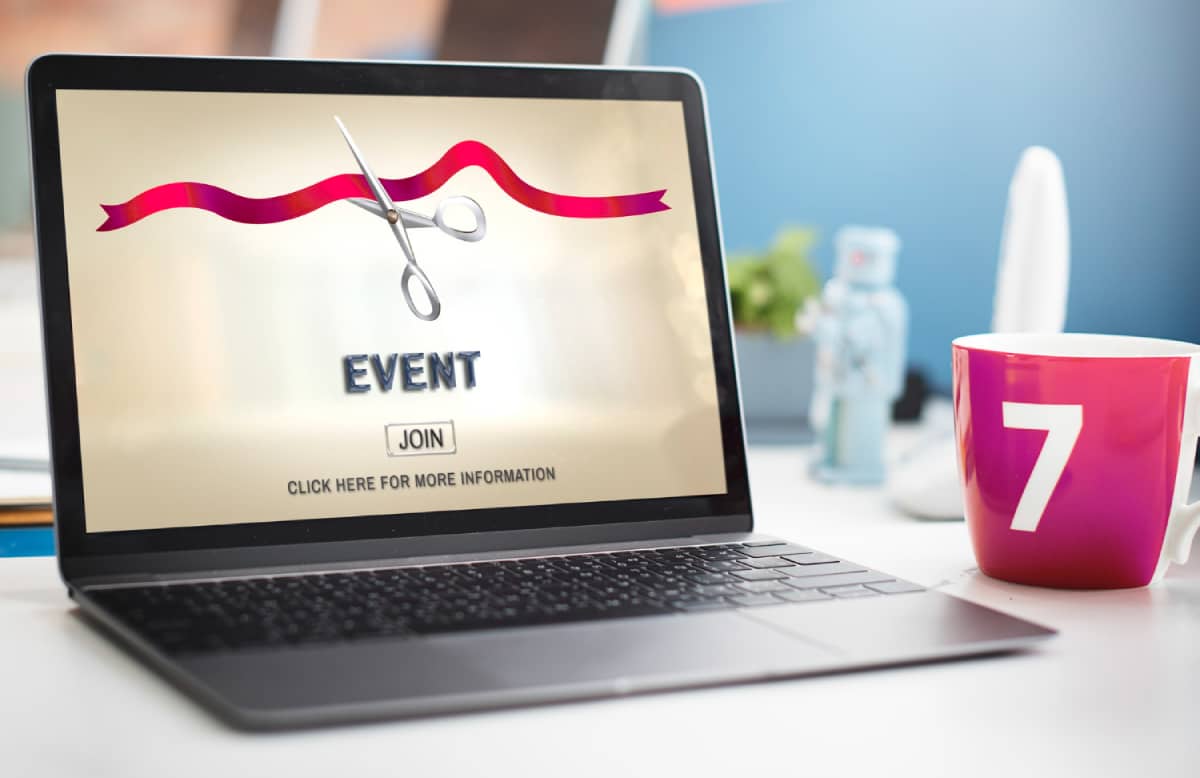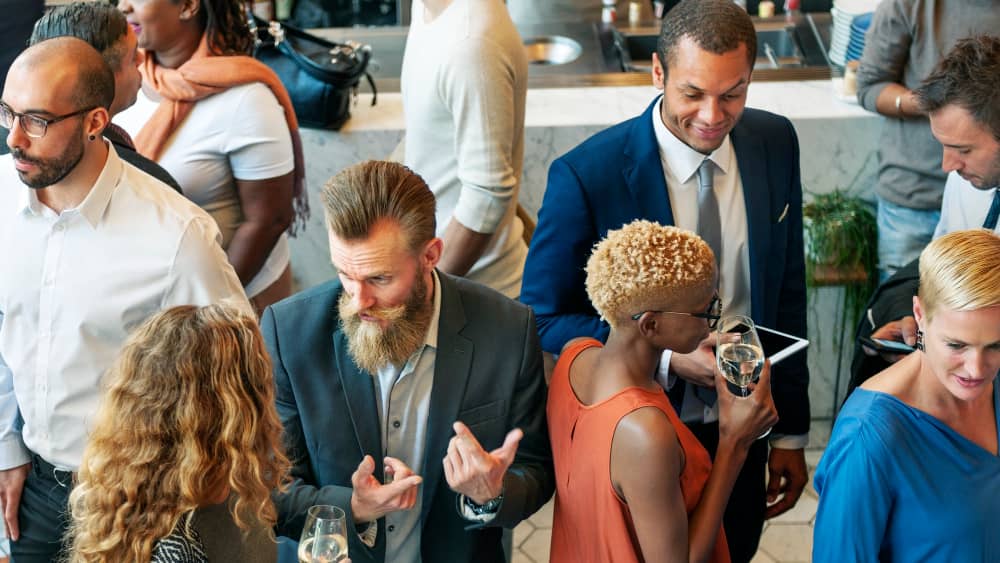
At its core, the world of promotional emails is dynamic and multifaceted. Its primary purpose? To attract attendees to your events and keep them engaged with your brand. The potential senders of these emails are as varied as the events they promote, ranging from trade fairs and shop openings to workshops and more.
“While we’ve previously focused on webinar promotions, this piece puts a spotlight on promoting other types of events. The principles, however, remain the same: Capture attention, create engagement, and maintain contact.”
Why Use Email Marketing for Event Promotion?
- Targeted Audience Engagement: Unlike broad-spectrum advertising, emails are directed at individuals who’ve shown interest in similar events or topics, ensuring higher engagement rates.
- Cost-Effective: With minimal investment, email campaigns can yield significant returns, especially when compared to traditional advertising methods.
- Measurable Impact: Tools and analytics associated with email campaigns provide real-time feedback, allowing for adjustments and optimization.
Exploring the Benefits of Event Promotions via Email
According to statistics, event-related emails have an average open rate of 20.51%. They act as a powerful tool to engage with your audience, build brand credibility, and ultimately drive attendance to your event. Let’s dive into the benefits of promoting your event via email:
- Reach a specific audience. Event organizers can segment their email lists based on demographics, interests, and previous attendance, allowing them to tailor their messages to the right people. This ensures that the recipients are genuinely interested in the event, increasing the chances of conversion.
- Deliver personalized messages. They can address recipients by their names and provide relevant event details based on their preferences. This personalized approach makes attendees feel valued and increases their engagement with the email content.
- Build relationships with attendees. By regularly communicating with them through email, event organizers can nurture these relationships and create a loyal following. This not only increases attendance rates for future events but also creates advocates who will spread positive word-of-mouth.
- Track your marketing efforts. They can monitor open rates, click-through rates, and other metrics, enabling them to measure the success of their email campaigns. This valuable data helps them refine their strategies, improve their targeting, and optimize their messaging for better results.
- Selling more tickets. Studies have shown that email has a high ROI and click-through rates, making it an effective channel for conversion. By including compelling calls to action and providing easy ways to purchase tickets, event organizers can drive ticket sales and maximize attendance.
Crafting the Perfect Email Sequence for Event Promotion
- Initial Promotion:
Begin by creating anticipation. Use compelling visuals and teasers about what attendees can expect, making sure to leverage both your existing mailing list and any lists of past attendees.
- Frequency and Timing:
Timing is crucial. Too frequent, and you risk annoying potential attendees; too sparse, and they might forget. A balanced approach, such as an announcement a month prior followed by reminders at strategic intervals, works best.
- Content and Design:
Content should resonate with the event’s essence. For instance, a shop opening might focus on exclusive offers, while a workshop could emphasize the expertise of the speakers. Visuals should be high-quality, relevant, and accompanied by clear calls-to-action.
- Utilizing Tags:
With email tags, you can categorize your emails based on the event type, audience segment, or campaign phase. This ensures that you can quickly locate and reference specific emails, streamlining your campaign management process. Email tags offer a streamlined way to tag and categorize emails, ensuring no potential attendee falls through the cracks and using tags in your email marketing platform allows you to better manage your campaigns and target groups.
- Post-Event Communication:
Post-event engagement is as crucial as pre-event promotion. A thank-you email not only shows appreciation but can also be a platform for gathering feedback, promoting future events, or offering exclusive deals to attendees.
Creating Eye-Catching Email Designs for Event Promotion
Creating engaging, visually appealing email designs can significantly improve your event promotion efforts. When formulating the aesthetics of your email, remember that it serves as the first impression and an invitation to your event. Thus, every element should be meticulously chosen and arranged.
Begin with a captivating subject line. The subject line functions as the headline for your email and should immediately grab the recipient’s attention. Keep it succinct, unique, and relevant to the event you’re promoting.
- Tip: Utilize A/B testing to determine which subject lines resonate most with your audience.
The header image is the next crucial element. An eye-catching, relevant, high-quality image can significantly increase open rates and engagement. Ideally, the header image should be related to your event, whether it’s a graphic representation, a picture of the venue, or an image from a previous similar event.
- Note: Ensure your images are optimized for email and mobile viewing to avoid long loading times or distorted visuals.
Next, ensure your email’s body content is concise but informative. The introduction should provide a brief overview of the event, followed by the details – who, what, where, and when. Make sure to include a call-to-action encouraging recipients to register for the event.
Your email layout should be clean and organized. Break up text with relevant images or graphics, and use bullet points or numbered lists where appropriate to make your content easily digestible.
If it is possible, you may consider collaborating with your company or a freelance graphic designer to come up with a concept that has a distinct visual identity for the event. This could include designing a logo, choosing color schemes, and other relevant elements, especially if it is a recurring event.

Optimizing Event Landing Pages for Email Campaigns
The most effective email marketing campaigns are typically supported by a well-optimized landing page. This is a specially designed web page that is streamlined for conversion, encouraging recipients of your promotional emails to take the desired action, such as registering for your event.
Creating a landing page for your event is a critical component of your email marketing strategy. Your landing page should be designed with the primary purpose of converting visits into registrations or sales. When readers click on the call-to-action (CTA) in your email, they can be directed to this landing page, where more detailed information about the event is provided, and an opportunity for them to register or make a purchase is available.
Key Elements of an Optimized Event Landing Page
- Compelling Headline: Your headline should be attention-grabbing and clearly convey the benefit of attending your event. It’s the first thing visitors see, so ensure it’s compelling enough to keep them on the page.
- Event Details: Provide essential information about the event, such as date, time, venue, and speakers. Make sure this information is accurate and easy to understand.
- Visual Appeal: Use high-quality images, videos, or graphics that are relevant to the event. Visuals can help create a more engaging and memorable experience for your visitors.
- Clear Call-to-Action: Your CTA should be bold and clear, urging the visitor to register for the event. It’s often beneficial to place this in multiple locations on your page.
- Testimonials: Including testimonials from past attendees can help build credibility and encourage new registrations.
Remember, the goal of your landing page is to convert visitors into attendees. Therefore, every element should be designed with this goal in mind, ensuring a smooth journey from the email to the event registration.
Highlighting the Benefits of Attending Your Event
Highlighting the benefits of attending your event in your email marketing campaign is crucial. This not only piques the interest of potential attendees but also gives them a clear understanding of what they stand to gain by participating.
Start by outlining the unique selling propositions of your event. It might be an exclusive networking opportunity, an engaging speaker line-up, or cutting-edge workshops that participants won’t find elsewhere. These factors essentially differentiate your event from others in the market.
- Networking Opportunities: If your event provides a platform for networking, emphasize this. Many professionals attend events primarily to connect with like-minded individuals and industry leaders. Point out potential networking opportunities in your promotional emails.
- Exclusive Content: If your event offers exclusive content or experiences that participants can’t get elsewhere, highlight this. Whether it’s an industry expert speaking on a niche topic or an innovative workshop, these unique features can attract attendees.
- Professional Development: For many, events are about learning and professional growth. Emphasize the ways your event can contribute to attendees’ skill sets and industry knowledge.
- Entertainment Value: Don’t shy away from highlighting the fun aspects of your event. Whether it’s a live music performance or a gourmet food experience, the promise of an enjoyable time can greatly enhance interest in your event.

How can existing mailing lists be leveraged for event promotion?
Existing mailing lists can be a valuable asset when it comes to promoting events. One way to leverage these lists is by segmenting them based on relevant criteria such as location, industry, or past event attendance. By targeting specific segments, event organizers can ensure that their promotional emails reach the right audience who are more likely to be interested in attending the event. For example, if the event is a trade fair for the tech industry, segmenting the mailing list to include only subscribers who have shown interest in technology-related content can increase the effectiveness of the promotion.
Sending Reminder Emails to Boost Event Attendance
Reminder emails play a pivotal role in driving event attendance. These timely nudges can re-engage potential attendees who may have forgotten about the event or still be on the fence about attending. With strategic planning and tactful execution, reminder emails can significantly boost your event’s attendance rate.
Timing is Key
The timing of your reminder emails can significantly impact their effectiveness. It’s a delicate balance: send it too early, and your invitee may forget again; too late, and they may not have time to plan for the event. Generally, a reminder email should go out a week before the event and then a couple of days before. For significant events like trade fairs and shop openings, an additional reminder on the morning of the event can help drive last-minute attendees.
Personalization Matters
Personalization can make your reminder emails more effective. Using the recipient’s name in the email can make it feel more personal and less like a mass marketing message. If possible, add personalized content based on their interests or past interactions with your brand. This can make the recipient feel valued and increase their likelihood of attending the event.
Highlight Key Event Details
Each reminder email should highlight the key details of the event: date, time, location (or login details for virtual events), and the names of any notable speakers or presenters. Including an itinerary or schedule can also be beneficial, especially for day-long or multi-day events. Remember to emphasize any changes or updates since the last communication.
Express Urgency and Scarcity
Creating a sense of urgency and scarcity can compel your potential attendees to act. Phrases like “limited seats remaining” or “last chance to register” can encourage recipients to promptly secure their spot at your event. However, it’s crucial to use this strategy responsibly and ensure the information you’re sharing is accurate.
Include a Clear Call to Action
Your reminder email should end with a clear and compelling call-to-action (CTA). Whether it’s “Reserve Your Seat Now” or “Confirm Your Attendance”, make sure it’s prominent and easy for the recipient to follow through on. Remember, the goal of the reminder email is to drive action, so your CTA should be compelling and straightforward.
Crafting Post-Event Thank-You Notes and Follow-Ups
After your event has successfully concluded, your email marketing efforts should not stop there. This is the time to cultivate strong relationships with your attendees by sending personalized post-event thank-you notes. Such emails show your attendees that you value their time and participation, which can foster loyalty and ensure their attendance at your future events.
Start your thank-you email with a warm and genuine message of appreciation. Express gratitude for their participation and support. Try to make it as personalized as possible by including specifics of the event or the attendee’s involvement. For example, if they asked a question, made a comment, or contributed in a unique way, mention it. This shows that you not only appreciate their attendance but also their active participation.

Remember to include a brief recap of the event’s highlights in your thank-you email. This serves as a reminder of the value they gained from attending. You could also include links to photos, videos, presentations, or other materials from the event. This not only provides them with useful resources but also re-engages them with the event.
In addition to thanking your attendees, post-event emails are also an excellent opportunity to gather feedback. Encourage your attendees to share their thoughts and suggestions. This valuable insight can help you improve future events. Be sure to use this feedback to make necessary improvements and adjustments to your events and email marketing strategies.
Remember, the goal of post-event emails is not only to express gratitude but also to strengthen your relationship with your attendees, gather feedback, and promote future events. With thoughtful planning and execution, your post-event emails can significantly enhance your event marketing efforts.
Promoting Events with Email Marketing: Wrapping Up
Understanding and employing effective email marketing strategies can significantly boost your event promotion efforts. However, it’s vital to remember that successful email marketing isn’t a one-size-fits-all technique. You need to tailor your approach based on the type of event, the target audience, and your business goals.